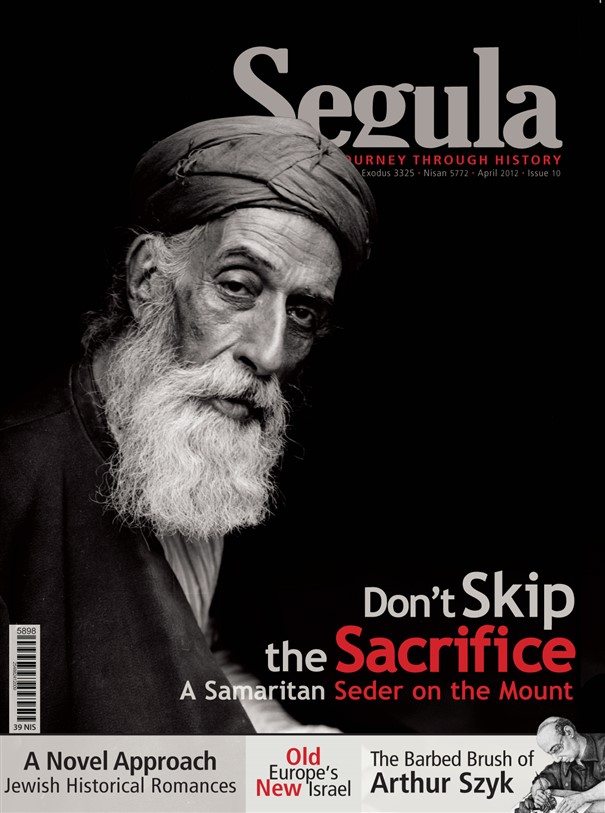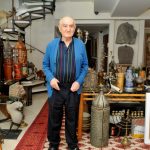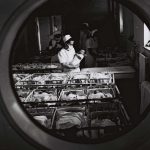Arthur Szyk fought valiantly as an officer in the Ukrainian army, but in defense of his own people, his most potent weapon was his brush. His cartoons assailed his enemies, while his patriotism found expression in richly ornamented declarations of independence – Polish, Israeli, and American
Individualism is perhaps the most central of artistic values. The artist’s individual expression is the linchpin of their creativity, so when their talents are harnessed by a regime or an institution, modern sensibilities expect them to be compromised, or at least limited. Communist art – and, arguably religious art – are merely the first examples that come to mind. Arthur Szyk, who died just over sixty years ago, was quite the opposite of the cosmopolitan artist whose art sets him above the violent struggles of national loyalties. Unashamed of his people and origins, he never hid his Jewish identity unlike many of his friends and colleagues. His art, as well as his life, was unabashedly devoted to his own personal struggle with the enemies of his people. But Szyk’s art was far from compromised. Perhaps the opposite – his sense of mission was a source of inspiration for some of his greatest works.
Arthur Szyk (1894-1951) was born in Lodz, Poland, and although he eventually immigrated to the United States, he never lost touch with the land of his birth. Like many Jews, especially during the first half of the 20th century, he was somewhat itinerant, spending time in Paris as well as in Palestine. Despite strong ties to Poland, his heart was truly always in the East, and he unhesitatingly and repeatedly engaged himself in the struggle for a Jewish homeland.
Szyk’s father, Solomon, was the well-to-do manager of a textile factory. His family was traditionally observant, and he was particularly proud of his lineage – he was descended from the illustrious Rabbi Yom-Tov Lipmann (1578-1654), author of the Tosfot Yom Tov commentary on the Mishna. Tragically, in 1905, he was blinded when a factory worker threw acid in his face during an uprising against the Russian Empire that came to be known as the Lodz Insurrection.
Arthur’s extraordinary artistic talent became apparent at an early age. He was particularly drawn to biblical scenes. Upon the advice of the young prodigy’s teachers, in 1909 his father sent him to study in Paris, where he was exposed to the latest artistic trends. But Arthur Szyk’s art was, to say the least, highly individualistic, unmarked by the modernism and surrealism of his day. The strongest influences on his work were illustrated manuscripts, carvings and paintings from the Middle Ages.
At age twenty, Szyk returned to Lodz and, extensive artistic endeavors notwithstanding, became deeply involved in Zionist organizations in the city. One such organization was Zamir, a choral society specializing in traditional and popular Jewish songs. Arthur joined a Zamir delegation to Palestine and visited Tel Aviv, which had been founded only five years earlier. Two newspapers, Hapoel Hatza’ir, and an Arabic daily, interviewed the young artist, who expressed his delight at being able to walk the land of his ancestors.
Armed with Brush and Rifle
The young artist befriended a number of Hebrew writers during his stay, especially the poet Yehoshua Shlomo Blumgarten, better known as Yehoash, the author of a Yiddish translation of the Bible. The two traveled all over the country, and Szyk also visited Yehoash at his home in the newly settled area of Rehovot, where the artist took his turn guarding the citrus groves. Attracted to the kibbutz movement, he spent time at Degania, the first such communal settlement, and some of his paintings immortalize day-to-day life on the young kibbutz. Szyk also spent many hours at the Western Wall in Jerusalem, sketching Jews of varied origin and from all walks of life at the holy site. He fraternized with students at the newly founded Bezalel Academy of Art and even taught there.
Szyk’s stay in Palestine was cut short by the outbreak of World War I. Forced to return home, he was recruited into the Russian army. He fought in the battle of Lodz, but managed to escape from the front in 1915 and spent the rest of the war as a civilian. This was a seminal period for Szyk. The first exhibition of his paintings was held in Lodz, including renditions of biblical figures and caricatures of Russian soldiers. He married Julia Liekerman in 1916, and in due course fathered a son and daughter.







